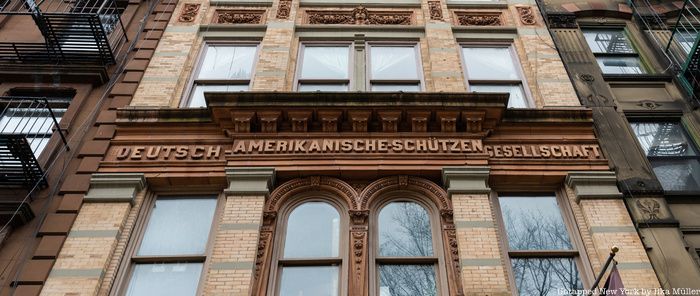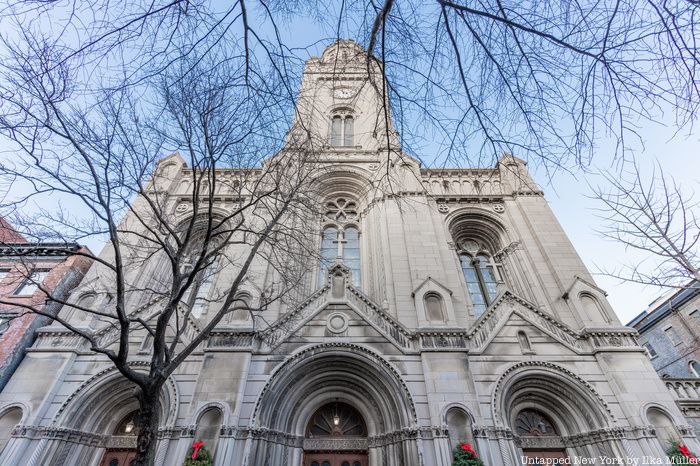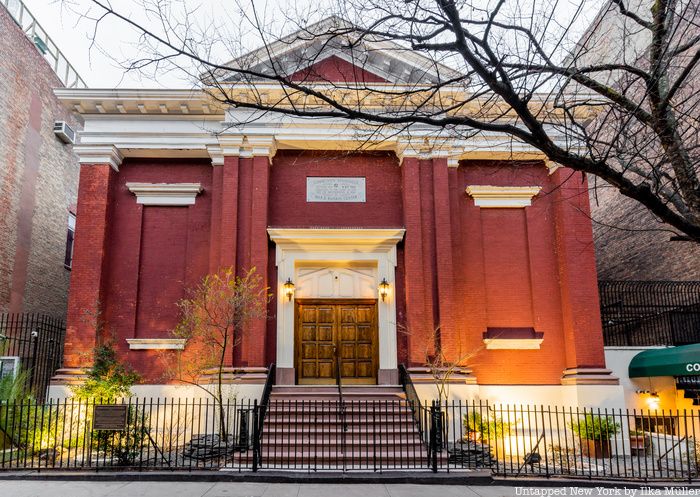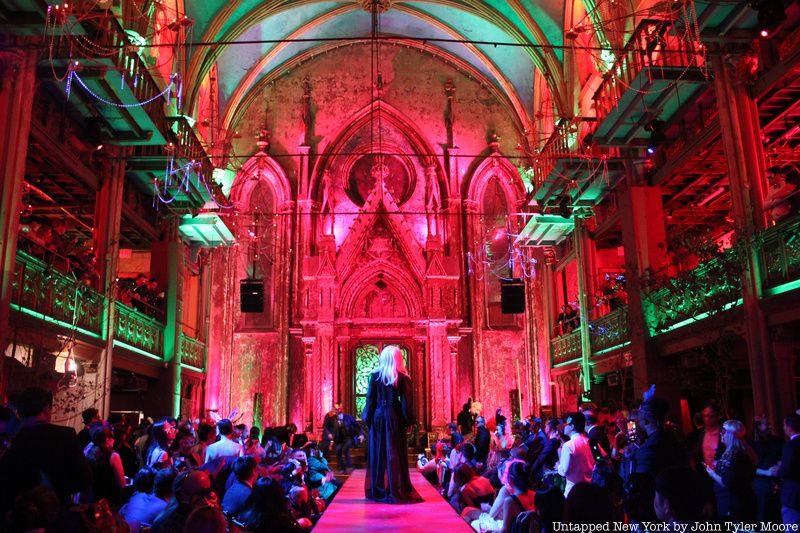Last Chance to Catch NYC's Holiday Notalgia Train
We met the voices of the NYC subway on our nostalgia ride this weekend!


The history of German immigration to New York, despite its large volume, lacks the same attention awarded to other migratory waves from Europe in popular narratives about New York as a city of immigrants. Throughout the nineteenth century, Germans were the second-largest immigrant group in New York, only behind the Irish, and the main non-English speaking immigrant group. The area around Tompkins Square Park in the East Village for most of the nineteenth century was at the center of Kleindeutschland or Little Germany, also known at the time as “Dutch Town” by non-Germans. Little Germany was arguably the first foreign-language urban enclave in the United States, if we discount Dutch New Amsterdam before the formation of the country. The diversity of this immigrant community is perhaps to blame for its inconspicuous presence in historical memory. German immigrants were a heterogeneous group, at times difficult to stereotype, that included Catholics, Protestants, Jews, freethinkers, and Forty-Eighters or political exiles from the 1848 Revolutions from a multiplicity of German kingdoms and principalities.

All photos by Ilka Müller
German immigration to New York in the nineteenth century was part of the second wave of German migration to the United States that followed the first wave (1683-1775). Migration costs in the eighteenth century restricted travel to immigrants with significant means or servitude contracts to front the costs. But changes in maritime transportation across the Atlantic led to an era of mass migration after 1830. The invention of slimmer and longer sail ships, known as clipper ships, improved travel times, leading to cheaper travel. For example, fares for transatlantic voyages fell from $70 to $22 by 1830. Later on, in the 1850s, the introduction of steamships reduced travel times even more.
The reduction in travel costs opened immigration to Germans from different economic backgrounds, leading to a period of mass emigration from Germany that transformed New York, above Philadelphia, into the main port of arrival for German immigrants entering the United States. By 1840 New York received 65 percent of German immigrants. From 1820 to 1920 5.5 million German immigrants entered the United States via the port of New York. In total, by 1880 New York had a German population of 350,000, making at that time the third-largest German-speaking city in the world after Berlin and Vienna.
 The Ottendorfer Library in the East Village
The Ottendorfer Library in the East Village
Consisting of 400 blocks, from Avenue D to 3rd Avenue and Bowery, and from East 14th Street in the north and Division Street in the south, Little Germany housed half of the German population of New York by 1855. This part of Manhattan, known later as the East Village, was at the time divided into four wards, 11th and 13th wards bordering the East River and 17th ward between Avenue B and Bowery, and 10th ward between Division Street and Rivington Street. The 11th ward, which today covers most of Alphabet City, then known as “rag pickers’ paradise, was the slaughterhouse district. This ward contained wood frame structures, separated by alleys and courtyards, located in undistinguishable industrial and residential zones. Both the 11th and the 13th wards were the location of shipyards, while the 17th ward was more residential with brick-and-mortar houses. Tenement living conditions were common in Little Germany, for example, the residential building, the Manhattan Place, located in the 13th ward housed 577 people in 96 rooms.

By 1875 Little Germany was over 64 percent German. Avenue B, known as German Broadway, was a commercial street of shops, sidewalk markets, and basement workshops, while Avenue A was famous for its beer halls and oyster saloons. In the southern part of Little Germany, Grand Street was a commercial area for the sale of dry goods. Occupationally, German immigrants were a more skilled group than other immigrants such as Southern Italians and the Irish. Germans dominated some specialized occupations such as shoemakers, brewers, furniture makers, and furriers. German domination of skilled trades and crafts led to nativist accusations that blamed German immigrants for lowering wages and the price of furniture for example. These skilled occupations allowed Germans, in contrast to other immigrants, to move into the American economic mainstream in fewer generations. By the second generation, a quarter of German-Americans worked as white-collar workers.
 The former German American Shooting Society at 12 St. Mark’s Place
The former German American Shooting Society at 12 St. Mark’s Place
German religious communities built some of the most iconic buildings of Little Germany, some of which are still present today. The heterogeneous character of the Little Germany immigrant community is evident in these buildings, which include a rectory, a Catholic church, a synagogue, and a Lutheran church. Other historic buildings include the then home to the German American Shooting Society, with its German name, the Deutsche-Amerikanische Schützen Gesellschaft, still carved into the front, and the Ottendorfer Library which was a gift from Oswald Ottendorfer (1826-1900), owner of the German-language newspaper the New-Yorker Staats-Zeitung, to the German neighborhood.

As the largest religious demographic within the German community of New York, German Catholics managed to build seven churches in New York before the Civil War. German Catholics manifested a strong sense of independence vis-à-vis other Catholic communities in New York, which were under the control of the Irish and Archbishop John Hughes (1797-1864), and insisted on worshipping exclusively in German churches.

St. Nicholas Rectory building
On 127 East 2nd Street in the East Village, German Catholics, led by Austrian Priest Johann Stephen Raffeiner, built the St. Nicholas Kirche in 1835. This church was demolished in 1960 to create room for a parking lot, but the rectory that was built next to the church survives to this day. Built according to a Gothic Revival style in 1904, the St. Nicholas Rectory was built to replace the school that had been next to the church since 1867. Another iconic building from Little Germany we still find today is the Most Holy Redeemer Church. This Baroque church with a 250-foot tower, located on 161-165 East 3rd Street, was built by the Redemptorist missionary order to house the congregation founded in 1844.

Sixth Street Community Synagogue
Although German Protestants were a minority in contrast to their Catholic co-ethnics, German Lutheranism had earlier roots in New York, dating back to the colonial era. St. Mark’s Evangelical Lutheran Church built in 1857 in a Greek Revival style, exists today as the Sixth Street Community Synagogue/Max D. Raiskin Center after thirteen Jewish women purchased the building in 1940. This former Lutheran Church is part of one of the most tragic events in New York history. On June 15, 1904, the St. Mark’s congregation sponsored the boat excursion on the General Slocum steamer which caught fire on the East River. With over 1,300 victims, this maritime catastrophe remained the deadliest single-day event in New York City’s history until September 11th, 2001. In 1906, on the northern side of Tompkins Square Park, a memorial fountain was dedicated to the victims of this catastrophe.

German Jews were also a visible and engaged part of Little Germany. Founded in 1825, the Anshe Chesed congregation constructed a Gothic Revival synagogue at 172 Norfolk Street in 1850. At that time, Anshe Chesed became the third Jewish Congregation in New York City after Shearith Israel (1654) and B’nai Jeshurun (1825). Anshe Chesed was also New York’s first German-Jewish synagogue and the second Reform synagogue after Temple Emanu-El (1845). German Jews were instrumental in spearheading the reform of Judaism in the United States, a movement which they had initiated in Post-Napoleonic Central Europe. Since 1986, this former synagogue functions as an art center, founded by the Sephardic painter and sculptor Angel Orensanz (b. 1940). In 1987, the building housing The Angel Orensanz Foundation and Center for the Arts received New York City landmark status.

An event inside the Angel Orensanz Foundation and Center for the Arts
The East Village is not the only part of New York City where the remnants of German immigration can still be found from settlement began to migrate uptown. A portion of the Upper East Side around 86th Street was once known as “Germantown” where you could find German butcheries and bakeries like Schaller & Weber and the recently-closed Glaser’s Bakery, a German department store and more. Temple Emanu-El was founded by German-Jewish immigrants and its current location its its fourth in Manhattan. The Zion St. Mark’s Evangelical Lutheran Church on 85th Street still stands, formerly the Deutsche Evangelische Kirche von Yorkville. The Upper East Side was also home to German breweries. In Chelsea, the Church of St. Paul’s remains the oldest continuously operating German-speaking church in New York City.

Inside the Church of St. Paul’s
The second wave of German immigration happened in the midst of different historical events on both sides of the Atlantic, which at times either increased or restricted immigration; these events include the Potato Famine of the 1840s, the 1848 Revolutions in the German States, the American Civil War, the Crimean War 1853-1856, the wars of German Unification in 1866-1871, and the Depression of 1873. However, above all these historical events which generated refugees, exiles and deserters, the demographic pressures on farmland division and the labor market—first in the south and west, and later in the east in Prussia—and the rapid industrialization of Germany in the latter part of the nineteenth century seemed to have had the largest influence on the ebb and eventual subsiding of German immigration to the United States.
By the end of the nineteenth century, German industrialization and a growing job market made internal migration for German workers a preferable option to overseas emigration. The second wave of German immigration to the United States was over, but not without leaving its traces on the built environment of New York City.
Learn more about Little Germany on our upcoming virtual talk, The Secrets of St. Mark’s Place!
Subscribe to our newsletter